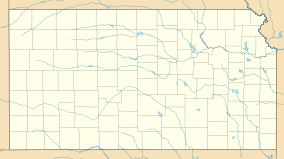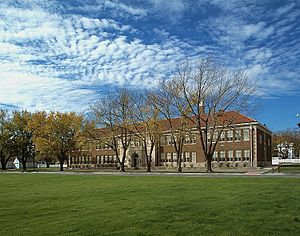Brown v. Board of Education National Historic Site facts for kids
Quick facts for kids Brown v. Board of Education National Historic Site |
|
|---|---|
| Location | Topeka, Kansas, United States |
| Nearest city | Topeka, Kansas |
| Area | 1.85 acres (0.75 ha) |
| Established | October 26, 1992 |
| Visitors | 16,886 (in 2011) |
| Governing body | National Park Service |
| Website | Brown v. Board of Education National Historic Site |
|
Brown v. Board of Education National Historic Site
|
|
| Location | 1515 SE Monroe St, Topeka, Kansas |
| NRHP reference No. | 01000156 |
| Added to NRHP | October 26, 1992 |
The Brown v. Board of Education National Historic Site is a special place in Topeka, Kansas. It was created on October 26, 1992, by the United States Congress. This site helps us remember a very important decision made by the U.S. Supreme Court.
That decision, called Brown v. Board of Education, aimed to end racial segregation in public schools. Segregation meant that Black and white students were forced to attend separate schools. On May 17, 1954, the Supreme Court said that "separate educational facilities are inherently unequal." This meant that having separate schools for different races was unfair. It also went against the 14th Amendment of the U.S. Constitution. This amendment promises "equal protection of the laws" for all citizens.
The National Historic Site includes the Monroe Elementary School. This was one of four schools in Topeka that Black children were forced to attend. The site also includes the land around the school.
Contents
History of Monroe Elementary School
The story of Monroe Elementary School started long before the Brown court case. In 1855, a man named John Ritchie bought land in Topeka, Kansas. Ritchie was an abolitionist, someone who worked to end slavery.
After the American Civil War, many formerly enslaved African Americans moved to Topeka. They built homes on Ritchie's land. Because so many Black families lived there, the school board decided to build a school for Black children in that area. This area became known as "Ritchie's Addition."
The first Monroe School was a small rented building used from 1868. A permanent school building was built in 1874. The current Monroe Elementary School building was built in 1926. It was designed by Thomas W. Williamson, a well-known architect in Topeka. The school was built with good materials and modern technology for its time.
Life at Monroe School
A teacher from Monroe, Barbara Ross, shared her memories in 2004. She felt that Monroe and other Black schools were good. They had very qualified Black teachers. She said they had the same textbooks as white schools. Black teachers were even on committees to choose the books.
However, things were not completely fair outside of school. Black people could not eat in certain restaurants or sit anywhere they wanted in theaters. Teachers coming to Topeka had to stay with Black families because they couldn't stay in motels.
Monroe was the newest of the four schools for Black children in Topeka. The other schools were Buchanan, McKinley, and Washington. Today, Washington school is gone. The Topeka Board of Education no longer owns the other schools.
In the Brown court case, the judges did not say that Black schools were worse in terms of buildings or books. Instead, they said that segregation itself was unfair to Black children. The court decided that keeping children separate based on race was unconstitutional. This is what made Brown v. Board of Education such a landmark case.
The court's decision stated:
Does segregation of children in public schools solely on the basis of race, even though the physical facilities and other "tangible" factors may be equal, deprive the children of the minority group of equal educational opportunities? We believe that it does.
Saving Monroe School
Monroe School closed in 1975 because fewer students were attending. The school district used the building as a warehouse. They also used the grounds for parking and fixing buses. Eventually, the school and its land were sold to private owners.
Monroe Elementary remained privately owned for over 15 years. Some owners wanted to turn it into offices or a private school. One owner, Mark A. Steuve, bought it in 1988 to use as a warehouse. In 1990, he planned to sell the building at an auction.
The Brown Foundation started a campaign to save Monroe Elementary School. They wrote many letters and met with local leaders. With help from the Trust for Public Land, the school was saved. The Trust for Public Land bought the property in 1991.
On October 26, 1992, President George H. W. Bush signed a law. This law made Monroe Elementary School the Brown v. Board of Education National Historic Site. The National Park Service took ownership of the site in December 1993.
 This article incorporates public domain material from websites or documents of the Recreation.gov.
This article incorporates public domain material from websites or documents of the Recreation.gov.
 This article incorporates public domain material from websites or documents of the National Park Service.
This article incorporates public domain material from websites or documents of the National Park Service.
Images for kids







